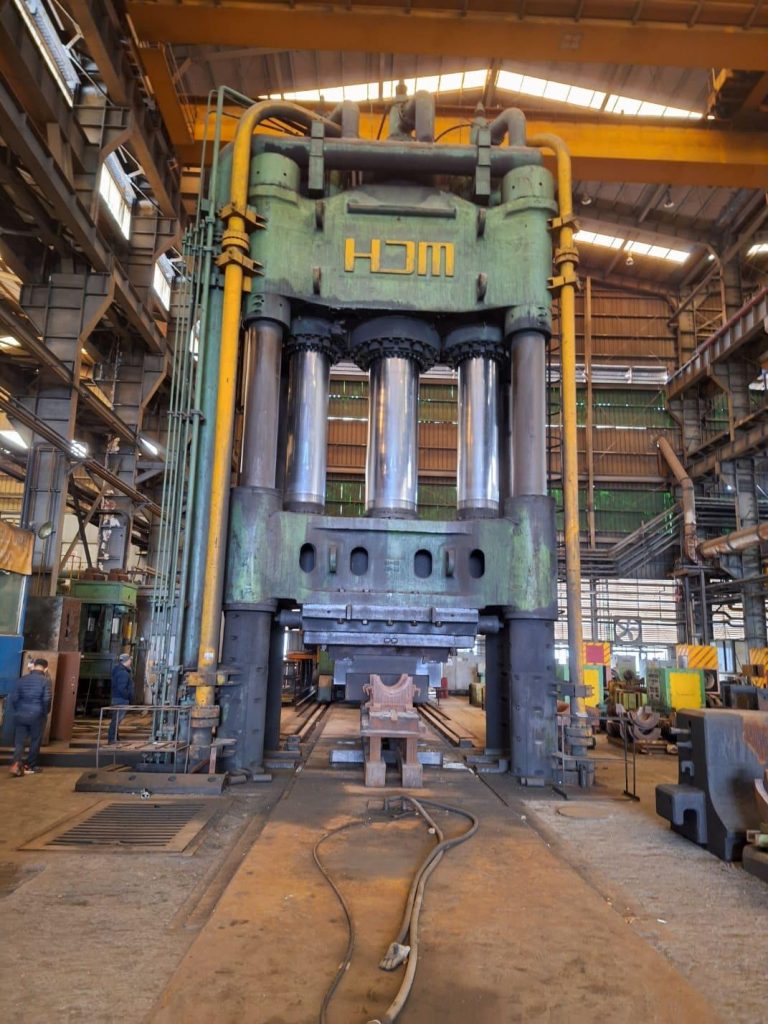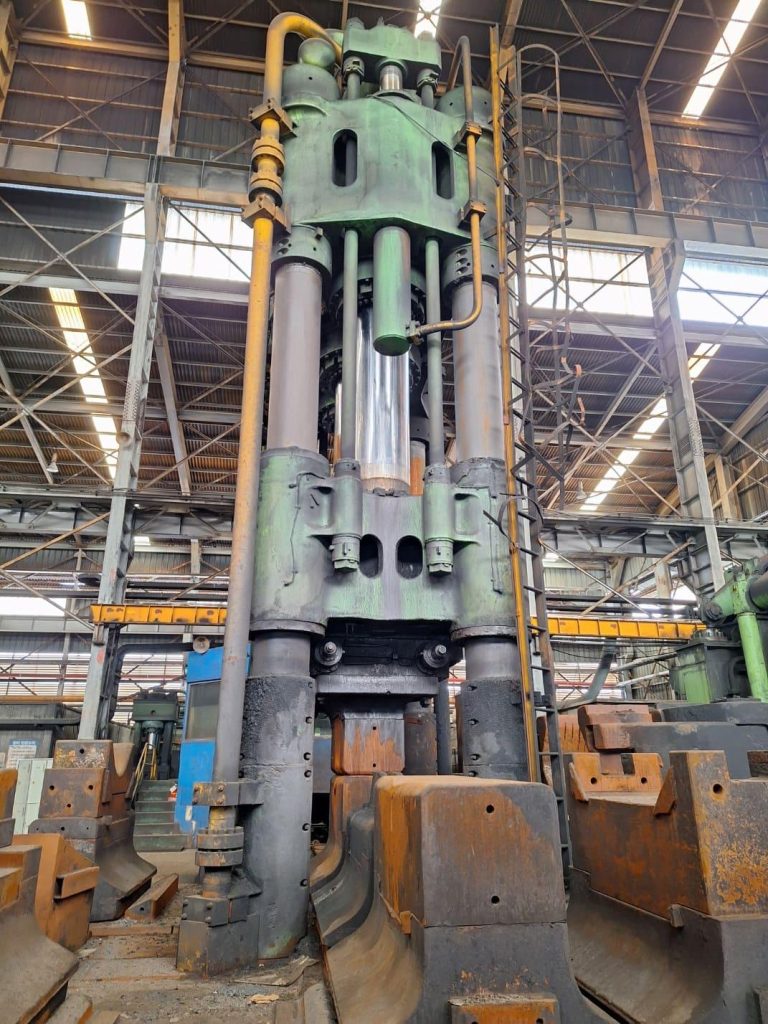What is 6500 Ton Open Die Forging Press?
Introduction to Open Die Forging Press
An open die forging press is a massive piece of industrial machinery used in the manufacturing of large, high-strength components by deforming metal under high pressure. The “6500 Ton” designation indicates the maximum force that the press can apply, which is 6500 tons. This type of forging press is essential in industries such as aerospace, automotive, shipbuilding, and heavy machinery, where large and complex parts are required.
Technical Overview of a 6500 Ton Open Die Forging Press
1. Basic Principle
Open die forging, also known as free forging, involves shaping a workpiece by applying successive blows or continuous pressure. Unlike closed die forging, where the material is confined within a set of dies, open die forging allows the metal to flow freely except where it contacts the dies. This process is typically used for large components where maintaining control over the material’s deformation is crucial.
2. Components of the Press
- Frame: The structure that supports the press, made from high-strength steel to withstand the immense forces involved. It ensures the stability and rigidity of the machine during operation.
- Ram: The moving part of the press that applies pressure to the workpiece. The ram is driven by hydraulic cylinders and can move vertically to compress the metal against the anvil.
- Anvil: The stationary base of the press where the workpiece is placed. The anvil must be extremely robust to handle the repeated impacts and high pressure.
- Hydraulic System: A crucial component that provides the power needed to operate the ram. The hydraulic system consists of pumps, valves, and cylinders designed to generate and control the high-pressure hydraulic fluid.
- Control System: Modern open die forging presses are equipped with advanced control systems, including programmable logic controllers (PLCs) and human-machine interfaces (HMIs). These systems allow precise control over the forging process, including ram speed, position, and force.
3. Operation Process
- Heating: The workpiece, usually a metal billet or ingot, is heated in a furnace to a temperature that makes it malleable (typically between 1200°C to 1250°C for steel).
- Positioning: The heated workpiece is placed on the anvil of the forging press.
- Forging: The ram descends, applying force to the workpiece. The operator or automated control system manipulates the position of the workpiece between each press stroke to achieve the desired shape.
- Reheating: Depending on the complexity and size of the workpiece, it may need to be reheated multiple times during the forging process to maintain its malleability.
- Final Shaping: The process continues until the workpiece reaches its final dimensions and shape. Additional operations such as trimming, punching, or surface finishing may be performed.
4. Materials and Products
Open die forging presses like the 6500 Ton model are used to process a variety of materials, including:
- Steel and Alloy Steels: Commonly used for high-strength components in various industries.
- Aluminum and Titanium Alloys: Essential for aerospace applications due to their strength-to-weight ratios.
- Nickel-Based Alloys: Used in high-temperature applications such as turbine blades and power generation components.
Typical products include:
- Large Shafts: For turbines, generators, and marine applications.
- Rings and Sleeves: Used in bearings, gears, and pressure vessels.
- Discs and Blocks: For manufacturing parts that require further machining.
- Custom Shapes: Tailored to specific industrial applications.
Technical Advantages of a 6500 Ton Open Die Forging Press
- Strength and Durability:
- Grain Refinement: The forging process refines the grain structure of the material, enhancing its mechanical properties and strength.
- Internal Soundness: Open die forging reduces internal voids and defects, resulting in a more homogeneous and defect-free workpiece.
- Versatility:
- Range of Shapes and Sizes: Capable of producing a wide variety of shapes and sizes, from simple bars and rods to complex geometries.
- Custom Forgings: The ability to produce custom forgings tailored to specific requirements.
- Quality Control:
- Precision: Advanced control systems ensure precise control over the forging parameters, resulting in high-quality components.
- Consistency: Repeated cycles and controlled deformation lead to consistent quality across multiple workpieces.
- Efficiency:
- Material Utilization: Open die forging typically results in less material waste compared to other manufacturing processes.
- Reduced Machining: The near-net shape achieved through forging reduces the amount of machining required, saving time and costs.
Applications of a 6500 Ton Open Die Forging Press
Aerospace Industry
- Landing Gear Components: High-strength steel and titanium forgings for landing gear structures.
- Engine Components: Nickel-based alloy discs and shafts for jet engines.
- Structural Parts: Large aluminum alloy components for aircraft frames.
Automotive Industry
- Crankshafts and Camshafts: High-strength steel forgings for engine components.
- Axles and Drive Shafts: Durable and reliable components for heavy-duty vehicles.
- Suspension Components: Forged parts for improved performance and safety.
Energy Sector
- Turbine Shafts: Large, high-strength steel shafts for power generation turbines.
- Pressure Vessels: Components for nuclear reactors and high-pressure applications.
- Wind Turbine Parts: Forged components for wind turbine hubs and shafts.
Shipbuilding Industry
- Propeller Shafts: Large, high-strength forgings for marine propulsion systems.
- Rudders and Bearings: Components for steering and stability.
- Anchor Chains: Forged links for heavy-duty maritime applications.
Conclusion
A 6500 Ton Open Die Forging Press is a vital piece of machinery in modern manufacturing, capable of producing large, high-strength components with exceptional precision and consistency. Its technical advantages, including refined grain structure, internal soundness, versatility, and efficiency, make it indispensable in industries such as aerospace, automotive, energy, and shipbuilding. The ability to handle a wide range of materials and produce custom forgings tailored to specific requirements further underscores its importance in high-performance applications. By investing in such advanced machinery, manufacturers can ensure the production of high-quality components that meet the stringent demands of today’s industrial standards.



